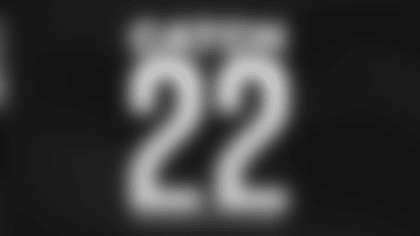The first wave of free agency for the Patriots didn't produce the "splash" signings that many hoped it would for a team flush with cap space heading into the offseason.
According to Over the Cap, the Patriots have spent the 12th-most cash in free agency in terms of maximum contract value. New England also ranks seventh in year-one cash given to free agents, so it's not that they didn't spend *any *money during the first wave. Instead, de facto GM Eliot Wolf mainly focused on retaining in-house free agents OL Mike Onwenu, TE Hunter Henry, WR Kendrick Bourne, pass-rusher Josh Uche, and edge-setter Anfernee Jennings, among others.
The disappointment stems from the lack of impact external additions. It's been quiet after losing out on prized free-agent receiver Calvin Ridley, who they were prepared to pay. Frankly, the depth signings acquired by the Patriots aren't moving the needle for a 4-13 team. Still, it's worth noting that trying to fix a roster that landed them with the third overall pick through free agency is a method that seldom yields sustainable results.
Instead, the plan for Wolf and company seems to be to set the roster up for a monumental draft. After retaining key in-house free agents and adding depth pieces, New England is positioning itself to target a franchise quarterback, top receiver, and starting left tackle in the draft. Can they hit on all three with their three top 100 picks? It's admittedly a lot to ask from one draft class. However, many would argue that this is the right way to approach a rebuild.
If the Patriots stick with their reported plan to draft a quarterback third overall, New England also added bridge quarterback Jacoby Brissett as an option to start the year, so they don't need to rush the rookie. Brissett was objectively competent as a starter with the Browns during the 2023 season under new offensive coordinator Alex Van Pelt. We'll have an in-depth review of Brissett that might change your mind about him. He is not a long-term answer, but Brissett is better than some think.
We'll have plenty of time to deliberate the best path forward for the Patriots. For now, let's focus on the free-agent additions they made in the opening week of the league year. Before we get into the film, nobody is trying to convince you that these players are future Hall of Famers. We aren't going into these breakdowns thinking they're adding Randy Moss, James White, Rob Gronkowski, Richard Seymour, and Dont'a Hightower, okay? We get it.
The Patriots personnel department saw something in these guys to bring them in, so let's discuss what they'll bring to the team:
WR K.J. Osborn, Projected Role: No. 3 Receiver in 11-Personnel/Backup Base Receiver
The Patriots made their first addition to the wide receiver room over the weekend by signing former Vikings wide receiver K.J. Osborn to a one-year deal, according to reports.
Although he's not the bonafide number-one receiver everyone is clamoring for, Osborn emerged as a legitimate role player in Minnesota's offense alongside Justin Jefferson, and then last season, with rookie Jordan Addison, who began gobbling up targets. Osborn has inside-outside versatility, play strength to box out man coverage defenders, and a veteran savvy to find the soft spots in zone coverage working across the middle of the field or on vertical stems.
Along with his skill set, Osborn played three seasons in a similar West Coast system as new offensive coordinator Alex Van Pelt's in New England. With the Kubiak's running the offense before head coach Kevin O'Connell took over in 2022, Osborn has grown up in the West Coast tree. All these offenses are cut from the same cloth, so it should be an easy transition for the 26-year-old receiver.
As for where he wins, Osborn has split time in the slot (383 snaps) and out wide (277 snaps) in certain packages. He mostly faced off-coverage in Minnesota, with only 27.3% of his routes coming against press coverage. Furthermore, of his 48 receptions in 2023, 33 of them came on either hitches at different levels (13), crossers (12), or dig routes (8). Osborn has some vertical juice and upper-body strength to defeat press coverage if the Patriots want to play him at the X-receiver spot, while he can also play a similar role to Kendrick Bourne's in recent years.
With the Pats wideout coming off a torn ACL last October, Osborn gives the Pats depth in case Bourne isn't at full strength to begin the season. Assuming they have Bourne at full strength, Osborn can also play as the third receiver in 11-personnel. Overall, this is a good depth signing to set up the wide receiver room for a big swing in the draft or via veteran trade.
On film, Osborn's ability to work in the middle of the field stands out. Above, the Vikings are running a zone scheme staple: post-dig. In this concept, the blocking scheme mimics a split-flow zone run with the tight end blocking across the formation. The run-heavy personnel from the offense gets the defense in a single-high safety shell, while the zone blocking pulls the linebackers out of the passing lane to the dig route. Osborn does well pushing vertically, leaning into the defender, and using his strength and leverage to snap off the break and create separation.
Along with using his play strength to win vs. man coverage, Osborn does a lot of his damage against zone coverage structures, with 34 of his 48 receptions coming vs. zone last season.
Here, Osborn is the backside receiver at the bottom of the screen on third down. The defense is playing inverted cover-two, where they rotate the passing strength structure post-snap. The quarterback works the backside dig away from the coverage rotation, and Osborn makes himself QB-friendly by settling into the zone void created by the seam-splitter.
Osborn wasn't targeted much on vertical routes. However, he did run them often, mostly to clear coverage, and occasionally, the ball would find him when the opportunities presented themselves.
This time, the middle of the field safety is giving away that he's playing the crosser by opening his hips toward the action on the play fake. Osborn has the backside vertical, where he gets single coverage without deep help and makes a nice play at the catch point for a big gain.
Patriots fans might be tired of the team adding complementary pass-catchers when the offense needs difference-makers. Osborn is not that because he's a one-speed runner with average skills after the catch. Still, there's a role for him in an NFL offense as a dependable and tough receiver who will go over the middle and block while he came up in big moments for the Vikings.
The Patriots now have the makings of a good WR2-4 between Bourne, Osborn, and Douglas. If they add a true No. 1 receiver, New England's offense can be functional with the depth pieces they have on the roster.
RB Antonio Gibson, Projected Role: Sub-Package/Receiving Back
The most compelling offensive addition for the Patriots so far is former Commanders running back Antonio Gibson.
Gibson peaked as a runner during the 2021 season, rushing for 1,035 yards and seven scores. Last season, he had 65 carries, playing over 85% of his snaps in the passing game. As a receiver, Gibson has an intriguing skill set. The former third-round pick ranked tenth among running backs with 389 yards on 48 receptions in 2023, his third-straight year with 40-plus catches.
Although his primary contributions will likely be in the passing game, Gibson's patience and burst allow him to be an effective gun-run back when the offense spreads the field. Gibson averaged 4.6 yards per rush on gun-runs last season, which is above the league average.
Gibson runs with good pace to allow his blocks to develop, picking his spots for when to utilize his 4.39-speed. Gibson effectively executes an outside zone scheme, making a decisive decision on his third step to get vertically upfield in the first example. In the next clip, he shows patience when slithering through traffic on an inside-zone RPO.
As a pass-catcher, Gibson's play speed shines, as does his collegiate experience at wide receiver. With that receiver background, Gibson can run downfield routes from the backfield and out wide alignments. He also has good ball skills to make adjustments on catchable but poorly placed throws, which is huge especially late in the down to rescue his QB.
Naturally, Gibson was primarily targeted in the flats (37) and on screen passes (12), as is the case with most running backs. However, he also had deeper targets on corner/out patterns (four), wheel routes (two) and caught his one-go route flexed out wide.
Here, the Commanders run a "scissors" concept, creating a three-vertical side with Gibson working out of the backfield. With the defense in man coverage, Washington creates a matchup for Gibson against Seahawks LB Bobby Wagner. Gibson's savvy to keep climbing vertically in his stem prevents Wagner from undercutting the route due to his inside leverage, so when Gibson snaps off the break, he easily separates from Wagner for a 19-yard touchdown.
The other area where Gibson shines is as a ball carrier on screen passes. The Pats new running back averaged over eight yards per reception with +60 yards after the catch over expectation on 11 screen receptions. As he does above, Gibson has good timing to allow his blocks to develop, and once again, his speed in the open field pops for a 36-yard gain.
Over the years, the Patriots have typically employed excellent receiving backs to serve as chain movers and matchup weapons out of the backfield. However, they haven't had a pass-game specialist since James White retired following the 2021 season. In the last two seasons, that has led to lead-back Rhamondre Stevenson playing over 62% of the offensive snaps. Stevenson has been asked to play on all three downs, and although he's a capable receiver, it's been a hefty workload.
Gibson is in a slightly different mold than James White, who was excellent at creating quick separation at the top of routes to be an outlet on third downs. Instead, the Pats' new pass-catching back is more of a speedster, with explosive releases into the flats to win foot races to the sticks or threaten linebackers on vertical routes.
Either way, Gibson will be a useful playmaker for the Patriots offense next season.
TE Austin Hooper, Projected Role: Backup Tight End/Early-Down Specialist
After re-signing veteran Hunter Henry, the Patriots began tinkering with their tight end depth chart behind one of their team captains as Van Pelt takes charge of the offense.
Hooper has an obvious connection to Van Pelt following two seasons with the new Pats OC in Cleveland (2020-21). Since then, he has spent one year with the Titans and Raiders. The 29-year-old isn't the productive receiver he once was when Hooper earned Pro Bowl nods with the Falcons. However, the goal seems to be to upgrade the run blocking from Mike Gesicki's TE2 spot with a player who is a known system fit.
Despite having good backs, the Patriots ranked 22nd in rush EPA last season. A sneaky reason why was that New England's tight end personnel didn't fit together. With Henry and Gesicki on the field together, the Pats lacked much help from the position block-wise, especially at the point of attack. Henry was serviceable, but he's not a difference-maker. At the same time, Gesicki is a liability as a blocker, so playing them together on early downs was an issue, and they didn't force heavier defensive personnel on the field to create mismatches in the passing game.
The Patriots discovered this early, signing blocking tight end Pharaoh Brown late in the summer, who was a pleasant surprise. However, Brown wasn't retained by the new regime, with Van Pelt likely vouching for his guy in Hooper (just like Bill O'Brien vouched for Brown). Hooper will hopefully be an upgrade with a history of more receiving production.
My initial reaction to the signing was that Hooper was similar to Henry as a more skilled receiver than a sturdy blocker. However, Hooper's run-blocking tape from last season was more encouraging than my previous exposures to him.
Hooper (no. 81) is a capable blocker, particularly in a zone-based scheme. He has active feet to effectively kick out edge rushers at the point of attack. In this example, he generates movement in the outside zone to open a rushing lane for the back. Hooper can also be trusted to kick out end-of-the-line defenders in gap/duo schemes or inside zone, which the Patriots will probably major in under AVP along with outside zone.
The Raiders also used Hooper on "sift" blocks on split-flow zone schemes to complement their other zone runs. Hooper chopping down the backside edge defender, who is initially left unblocked, allows the left tackle to combo block to the second level. Hooper routinely showed good technique on sifts to come across the formation to take out the unblocked defender.
On film, Hooper executes many of the run blocks that Van Pelt will likely task him with this season: sifts, second-level climbs, and kick-out blocks on rush linebackers in a two-point stance. We still wouldn't ask him to regularly block hand-in-the-dirt ends at the point of attack in the run game. But, overall, Hooper will be just fine as an early-down complement to Henry.
In the passing game, Hooper's targets mostly came on underneath throws in the flats or sitting between short zone voids. He'll be a reliable set of hands in that regard, with the ability to bump pass rushers on the way out into his patterns before becoming a check-down option. Downfield targets weren't very prevalent with the Raiders, but Hooper did flash on crossers and seam patterns.
The Patriots needed to restock the room with all three tight ends from last year's offense heading into free agency, with Hooper joining Henry to give them two reliable veterans.
DL Armon Watts, Projected Role: Rotational Interior Defensive Lineman
Next on the list is former Steelers defensive tackle Armon Watts, who fits the mold as a heavy-handed interior rusher with good length and noticeable first-step explosiveness.
Many connect the Watts signing to the Patriots releasing veteran DT Lawrence Guy after seven great seasons in New England. However, the film shows a different, more downhill style than Guy. Guy's specialty was his superb technique to absorb double-team blocks and reset single blocks to build a wall along the line of scrimmage in the Pats two-gapping system. There's a chance that Watts will rush from similar alignments as Guy, but he wins differently.
Last season, Watts generated 17 quarterback pressures on 155 pass-rushing snaps. Among all qualified interior rushers, Watts had the third-best pass-rush win rate on true pass sets, which removes screens and play-action drop-backs. The only two IDLs with higher win rates than Watts were Aaron Donald (29.6%) and Dexter Lawrence (31.1%). For the Pats, Christian Barmore ranked tenth at 21.3%. Obviously, the three Pro Bowl-caliber DTs did it with a much larger sample size, but the hope is Watts can have a breakout season with more playing time.
Watts (no. 94) has a go-to move that he usually sets up with a straight bull rush, and it's highly effective when he gets one-on-one reps with opposing guards. The move is a two-hand swipe, which Watts often pairs with a rip move finisher. With guards bracing for his power by throwing their hands early, Watts swipes their punch away, allowing him to get on the edges and bend.
The Patriots free-agent addition is a well-schooled hand fighter and quickly gains ground to turn the corner. However, as you can see above, the one critique is that his movements need to be more controlled to convert pressures into sacks. Despite having 17 pressures, Watts was only credited with a half-sack and three quarterback hits.
Right now, he's a disruptor but not a sack producer. On the one hand, Watts playing out of control at times is probably why he only played 27.7% of the defensive snaps last season. But the flip side is that his interior pressure affects quarterbacks while setting up others for sacks by moving QBs off their spot or preventing them from escaping through the middle of the pocket. Watts is also a capable penetrator on T/E and three-man stunts, which the Patriots use regularly.
As a run defender, Watts has developed more savvy since his college days when we last studied him closely. He can lock out his above-average length to press blocks, and his block recognition has improved. We probably wouldn't advocate for Watts taking on double teams at the point of attack, which Guy did regularly. But he can hold his ground against single blocks and defeat angled blocks with a quick first step. Here's a very translatable rep to the Patriots' run defense: Watts prevents the right guard from generating movement with his upper-body strength read and follows the running back into the gap.
The Patriots needed to keep the cupboard stocked along the defensive line, and Watts's production rates suggest he could become a known commodity with more playing time.
LB Sione Takitaki, Projected Role: Backup MIKE+Coverage LB/Special Teams Ace
The last addition we'll discuss is former Browns linebacker Sione Takitaki. Takitaki was well-liked by those in the know in Cleveland, who were disappointed they lost him in free agency.
Along with being a core special-teamer over the years, Takitaki's playing time on defense increased to a 61.1% usage rate last season. He was more than a kick coverage ace for the Browns defense, the second-ranked defense in DVOA during the 2023 season. Takitaki is no slouch, but like drawing comparisons to Guy for Watts, many think Takitaki was brought in to replace Mack Wilson.
In some ways, Takitaki's projected role will be similar to Wilson's with the Patriots. With captain Ja'Whaun Bentley as the early-down MIKE linebacker, Takitaki will play mostly on passing downs like Wilson. However, Wilson emerged as an effective pass rusher off the edge in the second half of 2023, which isn't something Takitaki does much. Furthermore, Wilson's impact was felt more on "splash" plays, whereas Takitaki is more of a steady snap-eater.
Takitaki's film isn't as flashy as Wilson's, but he's more consistent: a "do your job" type of off-ball linebacker. Although he plays with a great motor, Takitaki's play strength to attack blocks in the run game is below average. Therefore, he was mainly used to play middle-of-the-field zones, make plays unblocked vs. the run, and as an interior blitzer.
In coverage, Takitaki (no. 44) is a great zone-dropper with good awareness of route combinations and instincts to read the quarterback's eyes to clog passing lanes. Here, Takitaki is playing as a low-hole rat to help man coverage defenders. He gets Stroud to come off the juke option route from No. 2 to the left, then falls off to deter him from throwing to the short dig route, and Stroud forces a pass into the deep dig that is nearly intercepted.
Takitaki is also a capable zone defender on middle hooks, Tampa-2 coverage to run the shoot, and had good reps in trail technique with safety help over the top. Listed at 238 pounds, the 28-year-old has the movement skills in coverage to handle a wide range of responsibilities.
However, his smaller frame makes his run defense inconsistent. Takitaki shines as a run defender when he's moving unblocked laterally to defend outside runs. If you can keep him clean, Takitaki will make plays against the run, logging 13 stops. But he struggles to get off blocks and can be fooled by misdirection when trying to beat blockers to their landmarks.
Although his skill set doesn't typically lend itself to an early-down role in the Patriots defense, Takitaki can step in as an effective second-level coverage defender next season.
DISCLAIMER: The views and thoughts expressed in this article are those of the writer and don't necessarily reflect those of the organization. Read Full Disclaimer


































